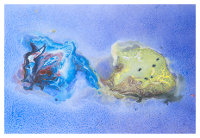Speaker
Description
Summary
The hadron spectrum has enriched significantly during the last years
thanks to the experimental activity of facilities such as BaBar, CLEO,
Belle, CDF and LHCb. In the open charm and open bottom baryon spectrum most
of the low lying states agrees quite well with quark model expectations.
However there are excited states that are not clearly assigned in the quark
model.
In 2003 the best candidate for a state beyond the naive quark model was found,
the $X(3872)$ [1], which is the most accepted candidate for a meson-meson
molecule. This state has challenged the naive quark model and a lot
of theoretical work to go beyond has been done during the last decade.
We have studied in a Chiral Constituent quark model possible hadron-hadron
molecules and found the $X(3872)$ as a $DD^\ast$ molecule coupled to $c\bar c$
configurations [2]. In this work we apply the same ideas to study the heavy
baryon spectrum in the open charm and open bottom sectors. We have
studied possible $D^{(\ast)}N$ ($\bar B^{(\ast)}N$) and
$D^{(\ast)}\Delta$ ($\bar B^{(\ast)}\Delta$)
configurations and found several bound states. The partial widths to the
most important decay channels has been computed within the same model.
For the $\Lambda_c(2940)$ [3] we find a $D^\ast N$ molecule very close in mass [4]. For this state the main decay channel is $DN$ in agreement with the observed
experimental width. This explains why it was discovered by BaBar in the
$D^0p$ invariant mass distribution, however we also find a sizable decay
into $\Sigma_c \pi$ where Belle confirmed the state.
We also find more exotic configurations like $D^{(\ast)}\Delta$ states. In particular
we find a $D^\ast \Delta$ with $I=2$ [5] with a mass close to the mass of the
$X_c(3250)$ [6]. This state has also been proposed to be a $D^\ast_0(2400)N$
molecule however the width of the state under this hypothesis is too big,
been our result in better agreement with the experimental data. The main
decay channel under our hypothesis would be $D^\ast N \pi$ while in the second
would be $DN\pi$. The experimental study of these two decay channels could
give a very important information to understand the structure of the
state.
Analogs in the bottom sector has also been found. As the position of the
states is close to the hadron-hadron threshold the discovery of these
states would confirmed the molecule character of both, open-charm and
open-bottom, states.
[1] S.K. Choi et al. (Belle Collaboration), Phys. Rev. Lett. 91, 262001 (2003).
[2] P.G. Ortega, J. Segovia, D.R. Entem, and F. Fernández, Phys. Rev. D 81, 054023 (2010).
[3] B. Aubert et al. (BaBar Collaboration), Phys. Rev. Lett. 98, 012001 (2007).
[4] P.G. Ortega, D.R. Entem, and F. Fernández, Phys. Lett. B 718, 1381 (2013).
[5] P.G. Ortega, D.R. Entem, and F. Fernández, Phys. Lett. B 729, 24 (2014).
[6] J.P. Lees et al. (BaBar Collaboration), Phys. Rev. D 86, 091102 (2012).
